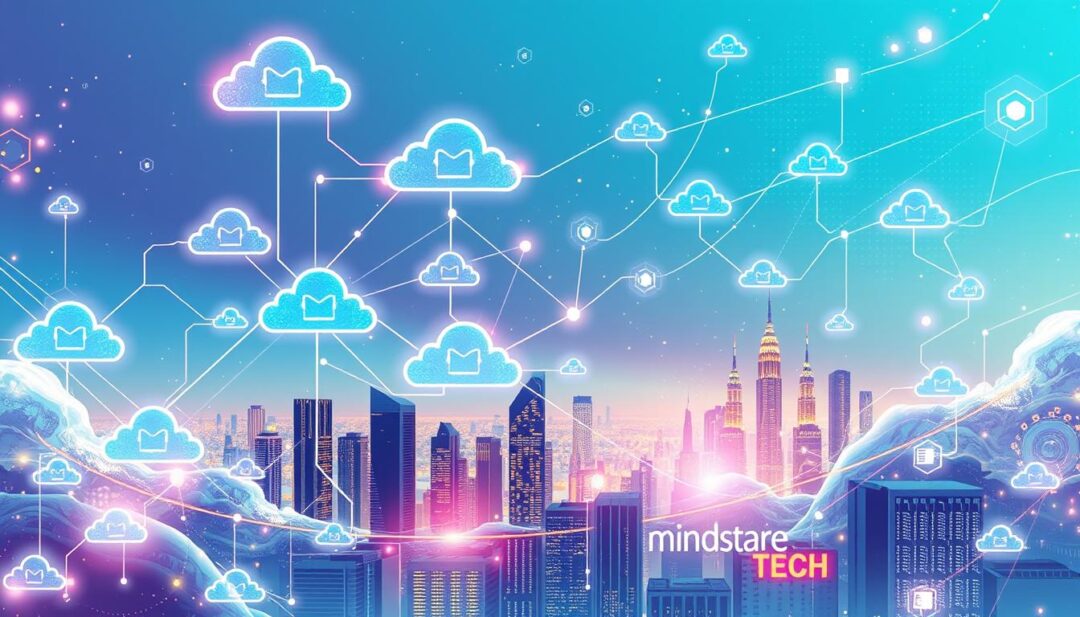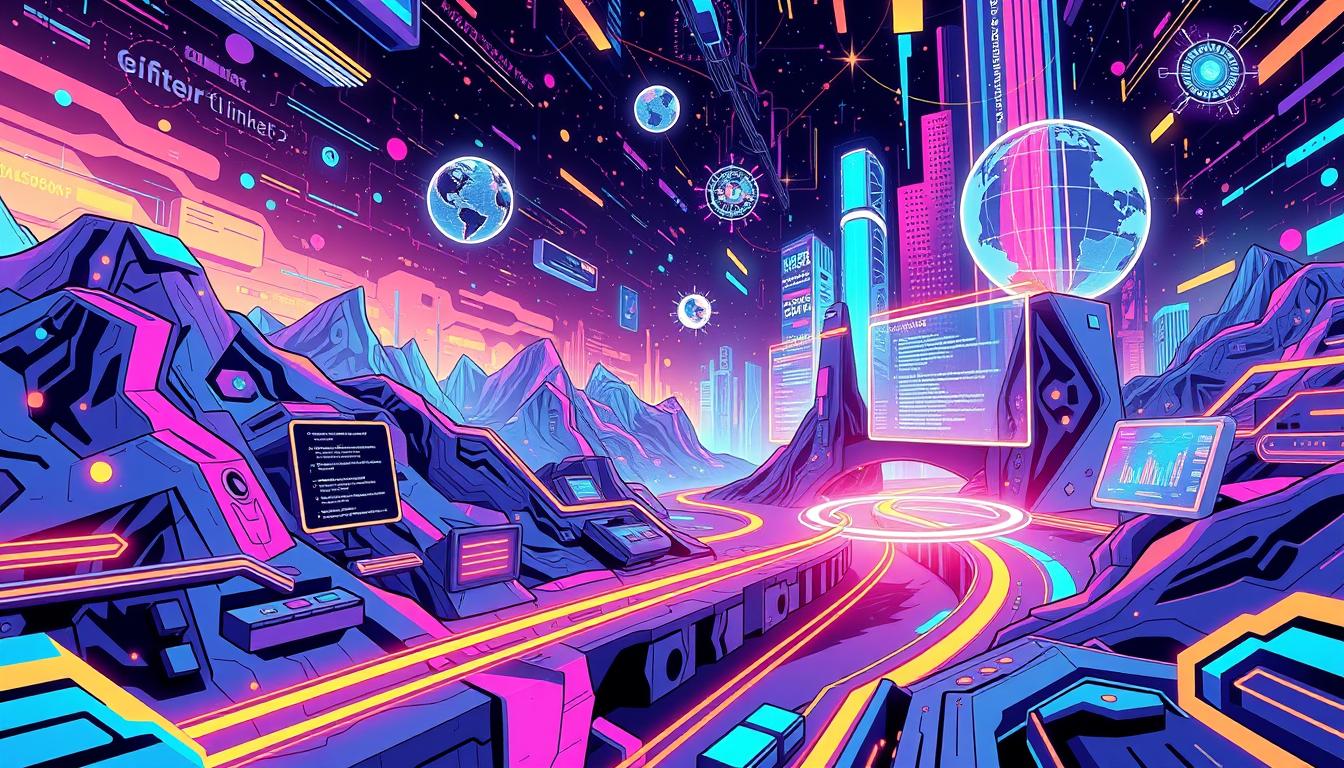The digital landscape is constantly evolving, with web development at its forefront. What was once static web pages has transformed into a dynamic, interconnected ecosystem. New technologies are rapidly changing how we build and interact with digital applications.
Industry experts predict that by 2025, 95% of customer interactions will be AI-driven. The global AR and VR market size is expected to hit $296.9 billion by 20241. Emerging technologies, 5G networks, and progressive web apps (PWAs) are ushering in a new era. This era will redefine how we create and experience the digital world.
This exploration will reveal the key trends and innovations set to reshape web development’s future. Artificial intelligence and machine learning are being integrated, along with advancements in serverless architecture and cloud computing. The digital landscape is undergoing a transformative shift. This shift will challenge and inspire web development professionals to explore new possibilities.
Key Takeaways
- The web development industry is evolving at a rapid pace, driven by emerging technologies like AI, AR/VR, and 5G networks.
- Progressive web apps (PWAs) are becoming the new standard, offering enhanced user experiences and performance.
- Artificial intelligence and machine learning are being integrated into web development, enabling personalized experiences and automated workflows.
- Serverless architecture and cloud computing are transforming the way web applications are built and deployed.
- The rise of low-code and no-code platforms is democratizing web development, empowering non-technical users to create digital solutions.
Evolution of AI and Machine Learning in Web Development
The web development field is undergoing a significant transformation, driven by AI and machine learning advancements. These technologies are changing how we build and interact with web applications. They are leading towards a future where personalized experiences, intelligent automation, and seamless human-machine collaboration are common.
AI-Powered Development Tools and Automation
AI-driven tools are making web development more efficient by automating tasks like SEO optimization and ADA compliance2. These tools analyze user behavior, suggest design improvements, and even generate code. This frees developers to focus on more complex and creative tasks3. Automated design systems use AI to create customized design templates based on user preferences. AI code assistants offer real-time optimization suggestions and help identify potential issues4. The market for generative AI in coding is expected to grow at a CAGR of 25.2% from 2022 to 2030, highlighting AI’s increasing role in web development.
Machine Learning for Personalized User Experiences
2 Machine learning algorithms allow web applications to analyze user behavior and preferences. This enables them to deliver personalized content, interfaces, and recommendations. Such personalized experiences enhance user engagement and satisfaction3. AI-driven websites offer tailored experiences that boost customer retention2. This data-driven approach is transforming web interactions, providing seamless and intuitive experiences tailored to individual needs.
Chatbots and Virtual Assistants Integration
2 AI-powered chatbots and virtual assistants are becoming essential in web applications, offering real-time customer support and reducing human intervention3. These AI chatbots provide personalized assistance, delivering immediate responses and solutions2. Voice-controlled interfaces, enabled by AI, are also gaining popularity, enhancing user interaction and efficiency on websites.
As the web evolves, AI and machine learning are driving unprecedented advancements in web development. These technologies are shaping the future of the web, enabling developers to create more intuitive, efficient, and user-centric web applications.
“AI and machine learning are reshaping web development, with AI-driven applications accounting for 15% of new app installations in 2023.”2
Progressive Web Apps: The New Standard
The web is rapidly evolving, moving from static pages to a dynamic ecosystem. This evolution has led to the emergence of Progressive Web Apps (PWAs) as the new standard. PWAs are designed to provide engaging, app-like experiences within web browsers5.
PWAs have become popular as a middle ground between traditional websites and native mobile apps. They leverage modern web technologies to offer a seamless user experience. This experience rivals that of dedicated mobile apps, without the need for downloads or installations5.
Major companies like Twitter, Starbucks, and Pinterest have adopted PWAs to enhance engagement and accessibility. Studies show that businesses using PWAs see a 36% increase in engagement and 50% faster load times5. This trend is expected to grow, especially among small and medium-sized enterprises looking for cost-effective solutions6.
PWAs offer several advantages over traditional web applications and native apps. They are cost-efficient, requiring fewer resources and less time to develop compared to native apps5. PWAs also benefit from better search engine optimization, improving their visibility in search results5.
PWAs can re-engage users through push notifications, delivering updates and enhancing retention5. Their cross-platform compatibility ensures a seamless experience across various devices, eliminating the need for separate app development5.
Moreover, PWAs offer offline functionality, allowing users to access content without an internet connection5. This feature is invaluable in areas with limited connectivity, ensuring a reliable user experience.
The adoption of PWAs is expected to grow as businesses seek cost-effective, engaging, and accessible solutions6. PWAs are set to redefine how we interact with web-based applications, shaping the future of web development.
The Future of Web Development
The web is on the cusp of significant changes, driven by technologies like 5G networks, IoT, AR/VR, and blockchain. These innovations are redefining web development7.
Emerging Technologies and Trends
5G networks promise faster, more seamless web experiences, with 1.2 billion devices expected to connect by 20247. AR and VR are moving beyond gaming, into retail, education, healthcare, and real estate. The AR and VR market is set to hit $296.9 billion by 20247. Blockchain is being applied in various fields, with over 4,000 active DApps in 20237.
Impact on Developer Workflows
These technologies are changing how developers work, demanding skills in AI, AR/VR, blockchain, and cybersecurity7. Web developers specializing in WebAssembly, AI, and Jamstack architecture may see higher salaries. Remote work also affects salaries, influenced by location7.
Future Skills Requirements
Technical skills are not enough; soft skills like communication, collaboration, and problem-solving are becoming essential7. Data analytics could influence salaries based on user engagement and business goals7. Keeping up with web development trends is key to success in the digital world7.
“The web is currently an ecosystem that’s dynamic and innovative, transforming how we construct and communicate using web applications.”
Serverless Architecture and Cloud Computing
The web development scene is rapidly changing, with serverless architecture and cloud computing leading the charge. Serverless computing, a cloud-based method that eliminates server management, is becoming more popular. It offers scalable, cost-effective solutions for web applications8.
Serverless architecture scales automatically with demand, fitting modern web apps with variable traffic well. The “pay-per-use” model in serverless computing cuts costs by only billing for actual usage. This shift lets developers concentrate on coding and feature development, not server management89.
Cloud giants like Amazon Web Services (AWS), Microsoft Azure, and Google Cloud provide serverless platforms like AWS Lambda, Azure Functions, and Google Cloud Functions810. These platforms ensure global availability, enabling apps to serve users worldwide with minimal latency8.
Serverless computing is a game-changer for businesses aiming to optimize resources and streamline development. Companies like Netflix, Coca-Cola, and iRobot have seen improvements in scalability and cost savings with serverless architectures810.
As the web development scene evolves, serverless architecture and cloud computing will be key in shaping web app futures. Businesses should evaluate their workloads, focus on event-driven use cases, and grasp pricing models to fully benefit from this transformative technology8.

| Feature | Traditional Server-based Architecture | Serverless Architecture |
|---|---|---|
| Server Management | Developers responsible for provisioning, scaling, and maintaining servers | Cloud provider handles all server management and scaling |
| Pricing Model | Fixed costs for server instances, even during low usage | Pay-per-use, only charged for actual compute time used |
| Scalability | Manual scaling required to handle traffic spikes | Automatic scaling based on demand |
| Developer Focus | Divided between infrastructure and application logic | Solely focused on writing code and building features |
“Serverless architecture has revolutionized the way we approach web development, allowing us to focus on innovation rather than infrastructure management.”
Rise of Low-Code and No-Code Platforms
The web development scene is witnessing a significant transformation, driven by the emergence of low-code and no-code platforms. These innovations are making web development more accessible, allowing individuals from various backgrounds to create applications without needing extensive coding knowledge11. Since their inception in the early 2000s, these tools have gained immense popularity, thanks to technological advancements and the growing need for rapid application development11.
Democratization of Web Development
Low-code and no-code platforms provide pre-built templates and components, speeding up the development process and making workflows more efficient11. They enable individuals with diverse backgrounds to contribute to development efforts, even without deep coding skills11. This has led to the rise of the “citizen developer” role, especially during the COVID-19 pandemic when tech companies faced a shortage of programming talent12.
Enterprise Adoption and Use Cases
Businesses are increasingly adopting low-code and no-code technologies, seeing their potential to cut costs, reduce time-to-market, and enhance productivity11. For instance, Unit4 leverages these tools to develop new functionalities in its ERP platform, offering flexibility based on security access rules and system configurations12.
Impact on Traditional Development
Low-code and no-code platforms offer significant advantages but are not a universal solution. They have limitations, unable to create fully-fledged applications or mission-critical software from scratch12. Nonetheless, they are valuable for creating screens, automating processes, and simplifying data integration tasks, among others12. As these platforms evolve, they will increasingly incorporate AI-driven automation tools11. Hybrid development approaches, combining the flexibility of code with the simplicity of visual development, will also gain popularity11.
Despite the progress in low-code and no-code technologies, it’s essential for organizations to fully understand these tools’ capabilities. They still rely on APIs and require coding and maintenance by expert programmers for complex tasks and customization12.
| Platform | Description |
|---|---|
| Microsoft Power Apps | A low-code platform that enables the creation of custom business applications without extensive coding knowledge. |
| Salesforce Lightning Platform | A no-code development environment that allows users to build and deploy custom applications on the Salesforce platform. |
| Google App Maker | A no-code tool that enables users to create custom web applications without writing code. |
| Webflow | A no-code web design platform that allows users to create responsive, professional-looking websites. |
| Bubble | A no-code platform that enables users to build web and mobile applications without coding. |
“The development of generative artificial intelligence (generative AI) is enhancing the programming process, facilitating the citizen development model, and further simplifying programming tasks.”12
Cybersecurity and Privacy Evolution
The digital world’s growth highlights the critical role of data protection, multi-factor authentication, encryption, and secure APIs in web development. In 2023, cyberattacks cost businesses a staggering $6 trillion globally, emphasizing the need for strong cybersecurity13.
Developers are integrating sophisticated security measures to protect user data and meet privacy regulations like GDPR and CCPA13. With over 58% of web traffic and nearly three-quarters of global ecommerce sales on mobile devices, ensuring secure mobile experiences is crucial14.
The rise of cloud services has expanded the attack surface for cyber threats, especially for services handling sensitive data13. To combat these threats, companies are using AI for threat detection and hunting to spot patterns and anomalies13.
Web development firms that showcase robust, compliant, and secure applications will appeal more to clients who value data protection and regulatory adherence. As users increasingly demand transparency and security, the ability to deliver secure, privacy-focused web experiences will set developers apart in the market13.
“Cybersecurity has become a mission-critical priority for businesses of all sizes. Developers who can incorporate advanced security measures and ensure compliance with privacy regulations will have a significant advantage in the market.”
WebAssembly and Edge Computing Advances
Innovative technologies like WebAssembly and edge computing are reshaping web development. WebAssembly, now six years old, allows developers to run code at near-native speed in web browsers. This enables complex applications to run efficiently on the web15.
Edge computing, meanwhile, brings computation closer to data sources. This reduces latency and improves response times. The combination of WebAssembly and edge computing is especially beneficial for applications needing real-time processing and high performance, such as gaming and financial services16.
Performance Optimization Techniques
WebAssembly offers exceptional performance, running almost as fast as native code17. It’s ideal for performance-intensive applications, enhancing user experience by reducing latency and improving responsiveness. The integration of service workers with WebAssembly also enables powerful web applications. These applications offload work from the server to the client efficiently15.
Distributed Computing Benefits
Edge network and serverless compute providers are now offering WebAssembly on their platforms. This allows “write-once-run-everywhere” code packages15. The distributed computing approach reduces bandwidth consumption, lowers latency, and improves user experiences17.
Cross-Platform Development Solutions
WebAssembly’s multi-platform compatibility is a game-changer for cross-platform development. It simplifies managing application dependencies across clouds and edges. This enables developers to create applications that run consistently across different devices and operating systems16. Its versatility, combined with a secure, sandboxed execution environment, makes it a powerful solution for modern computing environments. This includes edge deployments, AI applications, and the execution of large language models17.
The integration of WebAssembly and edge computing is set to revolutionize web development. It offers unprecedented performance, cross-platform capabilities, and efficient distributed computing solutions.
Sustainable and Green Web Development
As the web evolves, sustainability and environmental responsibility have become crucial for web developers. “Green coding” aims to create software that consumes fewer resources and has less environmental impact. IT-related emissions are projected to account for 14% of global emissions by 204018. Web developers are now focusing on lowering energy usage through code optimization and reducing server usage.
Companies that prioritize sustainable web development attract environmentally conscious clients, especially in Europe and North America. This trend shows a growing commitment to ethical and environmentally responsible tech practices18. The internet’s electricity usage would rank it as the 6th largest country in terms of consumption, highlighting the digital activities’ significant energy impact18.
Strategies for sustainable web development include using renewable energy for data centers and implementing energy-efficient cooling systems. Companies like Google have invested in renewable energy and energy-efficient cooling for their data centers, achieving carbon-neutral operations since 200719. Green hosting providers, such as GreenGeeks, also use renewable energy and energy-efficient cooling to reduce electricity usage19.
Techniques like content delivery networks (CDNs), data compression, and caching can also reduce data transmission, leading to energy savings19. The future may see AI and automation optimizing websites for energy efficiency automatically. Industry-wide eco-design standards could also ensure sustainable web development practices19.

As the web evolves, web developers can play a vital role in promoting green coding, energy efficiency, and sustainable practices. These efforts minimize the environmental impact of digital technologies. By embracing these principles, the web development community can contribute to a more sustainable digital future.
Conclusion
The future of web development is vibrant, with rapid technological advancements and endless innovation. The web has grown from static pages to a dynamic ecosystem, changing how we access information and interact globally20. Web development is also evolving, with new technologies emerging quickly to transform web application creation and communication.
Technologies like AI and machine learning21 are changing the game, along with the rise of progressive web apps (PWAs)2022. Low-code/no-code platforms are also democratizing web development22. These advancements promise significant growth and change in the web’s future. Developers must keep up with these trends and adapt their skills to meet industry demands2021.,
As the digital world evolves, web development companies that adopt the latest technologies and focus on user experience will thrive2221., By leading in web development, we can create a more dynamic, secure, and inclusive digital space. This will meet the needs of businesses and users alike.
FAQ
What are the key trends shaping the future of web development?
How are AI and machine learning impacting web development?
What are the advantages of progressive web apps (PWAs)?
How are emerging technologies like 5G, AR/VR, and blockchain impacting web development?
What are the benefits of serverless architecture and cloud computing for web development?
How are low-code and no-code platforms impacting web development?
What are the key cybersecurity and privacy considerations in web development?
How are WebAssembly and edge computing advancing web development?
What is the importance of sustainability in web development?
Source Links
- https://medium.com/dare-to-be-better/the-future-of-web-development-41b637ee4def
- https://medium.com/@thehubops/the-impact-of-ai-and-machine-learning-on-modern-web-development-076710fe6e7c
- https://www.linkedin.com/pulse/ai-web-development-game-changing-evolution-octatude-lo0mf
- https://www.agilitypr.com/pr-news/public-relations/the-future-of-web-development-how-ai-will-revolutionize-the-industry/
- https://redskydigital.com/progressive-web-apps-pwas-the-future-of-web-development/
- https://www.schneideit.com/blogs/progressive-web-apps-the-future-of-web-development/
- https://www.geeksforgeeks.org/future-of-web-development/
- https://www.stan.vision/journal/the-rise-of-serverless-architecture-in-2024-transforming-modern-web-development
- https://medium.com/@interviewer.live/an-overview-of-serverless-computing-the-future-of-web-development-c2a6c7e7d00c
- https://medium.com/@GlideNick/understanding-serverless-architecture-the-future-of-web-development-8a2f6a27d175
- https://codefinity.com/blog/The-Rise-of-Low-Code-and-No-Code-Tools-in-Web-Development
- https://www.forbes.com/councils/forbestechcouncil/2023/08/11/how-low-code-and-no-code-software-impact-the-future-of-development/
- https://fieldeffect.com/blog/what-is-the-future-of-cyber-security
- https://linvelo.com/evolution-of-web-development/
- https://spin.atomicobject.com/edge-computing-hyperlocal/
- https://www.linkedin.com/pulse/why-webassembly-future-edge-computing-divyanshu-rai
- https://edgeuno.com/webassembly-the-multi-platform-solution-for-edge-computing-and-ai/
- https://medium.com/@ronins/sustainable-web-design-building-a-greener-online-future-d849a457ee8f
- https://www.linkedin.com/pulse/intersection-green-technology-web-development-mirza-hadi-baig-jwy4f
- https://blog.flutter.wtf/the-future-of-web-development/
- http://www.classicinformatics.com/blog/the-future-of-web-development
- https://dev.to/rashedulhridoy/the-future-of-web-development-emerging-trends-and-technologies-every-developer-should-know-1ceb




Leave a Reply